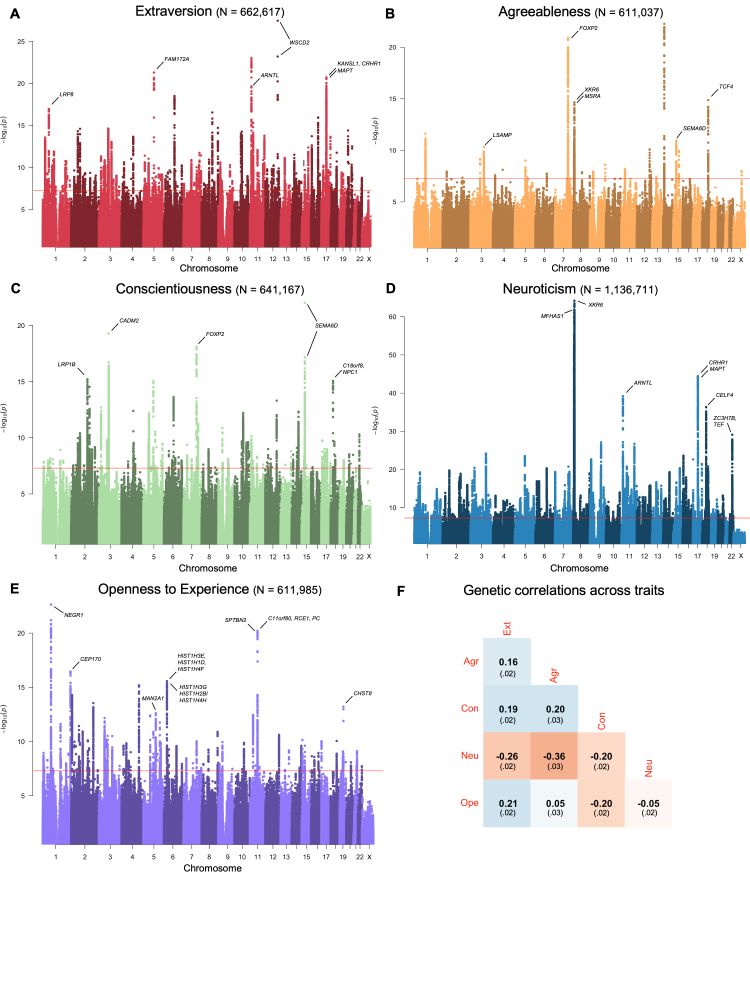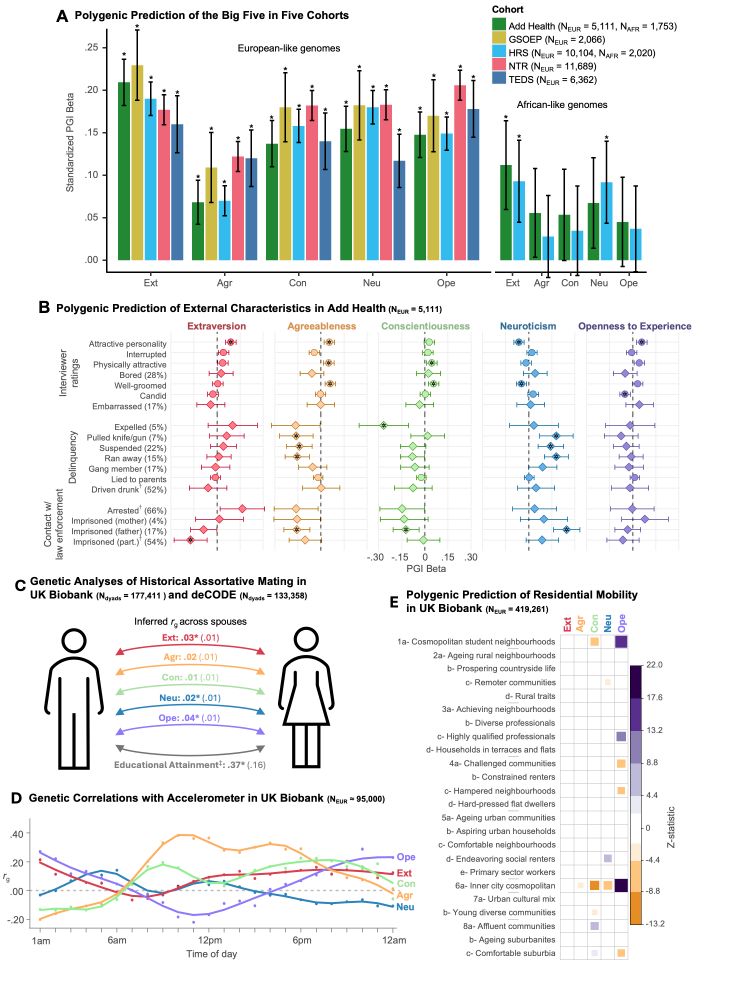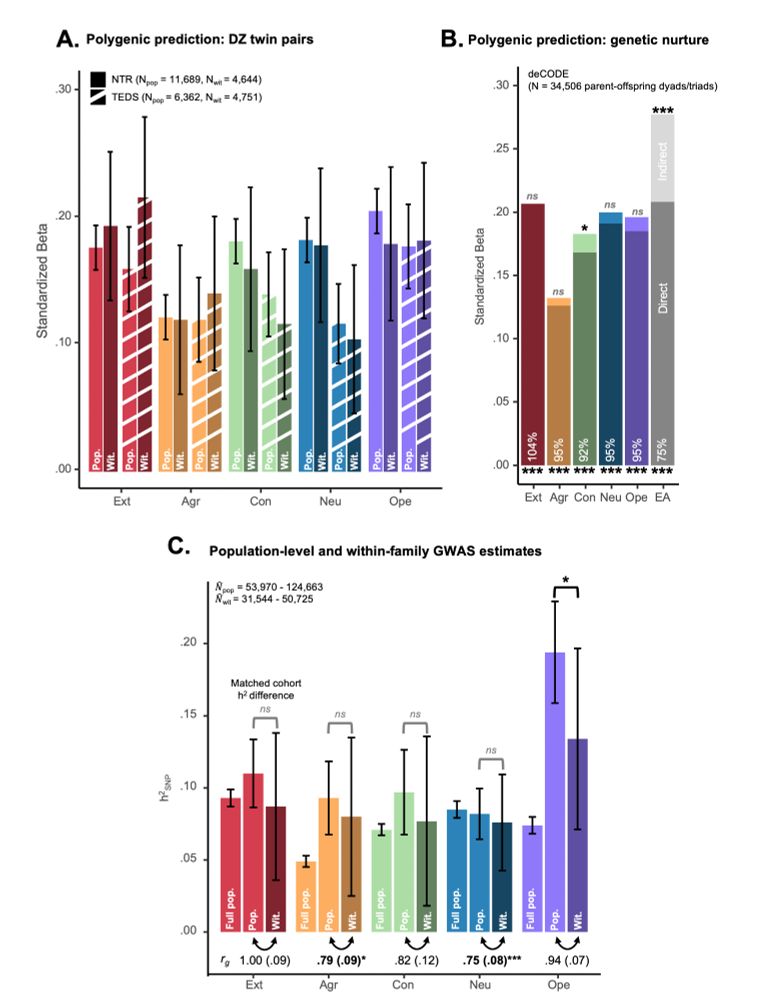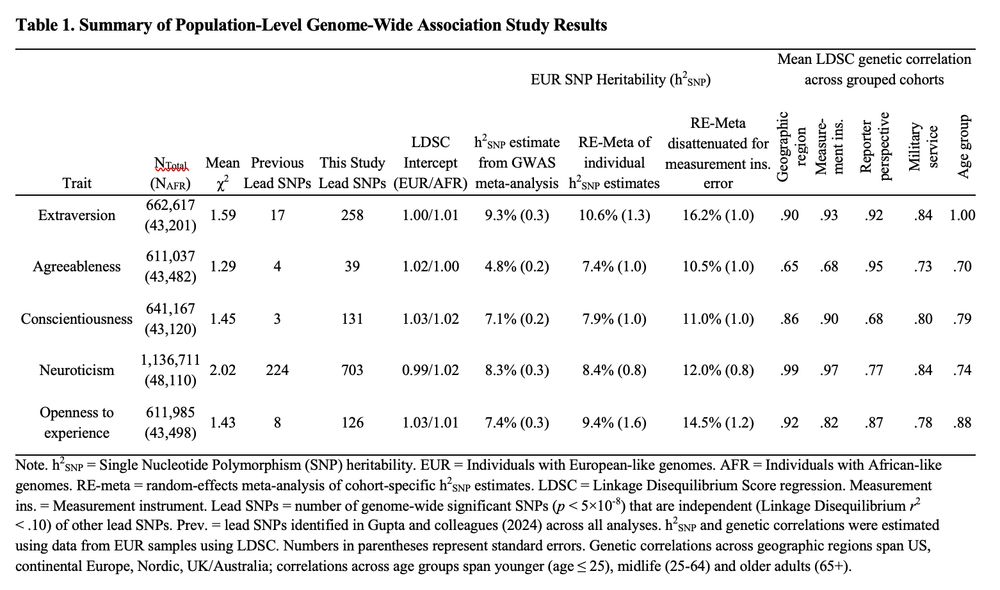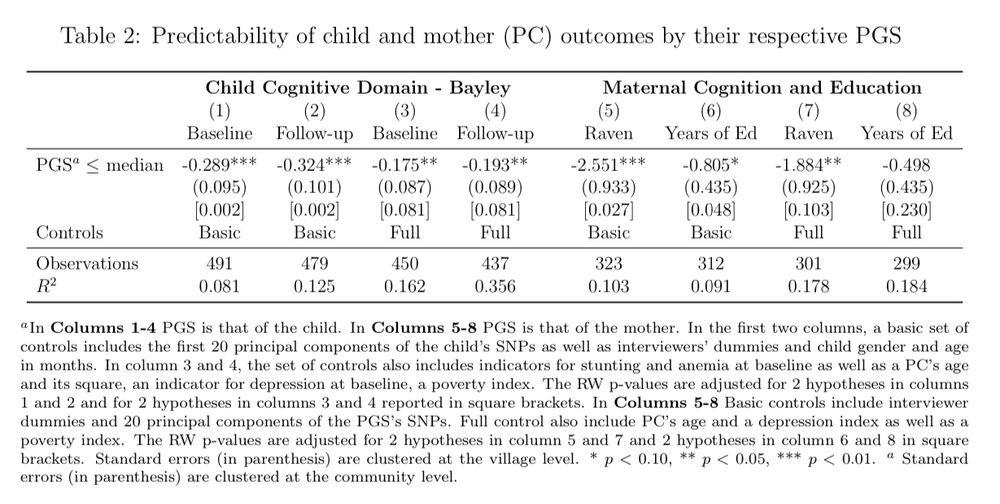Thrilled to see this joint work out!
Big thanks to my amazing coauthors: Silvia Barcellos, Leandro Carvalho, Titus Galama, and Marina Aguiar Palma. (8/8)
15.09.2025 09:41 — 👍 0 🔁 0 💬 0 📌 0
Key takeaway:
Even variation rooted in nature—our genes—exerts much of its influence through nurture. (7/8)
15.09.2025 09:41 — 👍 1 🔁 0 💬 1 📌 0
We quantify these three channels and find:
- Direct genetic transmission and genetic nurture both play substantial roles
- Assortative mating is comparatively minor
- For wealth outcomes, genetic nurture > direct transmission (6/8)
15.09.2025 09:41 — 👍 1 🔁 0 💬 1 📌 0
This shows parental genes matter not only through direct inheritance but also via:
- Genetic nurture – how parental genes shape the child’s environment
- Assortative mating – non-random partnering patterns (5/8)
15.09.2025 09:41 — 👍 0 🔁 0 💬 1 📌 0
Our findings: "next-generation" effects of parental PGI on children's outcomes are surprisingly large, as compared to "same-generation" effects (the effects of the parent's PGI on their own socioeconomic status). (4/8)
15.09.2025 09:41 — 👍 1 🔁 0 💬 1 📌 0
To isolate causality, we exploit the natural randomization of genes at conception, conditioning on grandparents’ PGIs.
This lets us separate pure genetic transmission from environmental effects. (3/8)
15.09.2025 09:41 — 👍 0 🔁 0 💬 1 📌 0
Using a unique linkage of genetic data from Lifelines_NL and administrative records from Centraal Bureau voor de Statistiek (CBS), we ask:
How do a parent’s genes associated with educational attainment—measured by a polygenic index (PGI)—affect their children’s socioeconomic outcomes? (2/8)
15.09.2025 09:41 — 👍 0 🔁 0 💬 1 📌 0

Genetics play a role on the persistence of socioeconomic across generations: one generation's genetics significantly impacts the education, income, and wealth of the next, from Sjoerd van Alten, Silvia H. Barcellos, Leandro Carvalho, Titus J. Galama, and Marina ... https://www.nber.org/papers/w34208
11.09.2025 13:00 — 👍 8 🔁 1 💬 0 📌 1
Microsoft Forms
Call for abstracts: genetics, economic & social issues.
We're hosting a 1-day workshop on using genetic data to examine economic & social issues on 12th December at UCL’s Social Research Institute. More info & submission at link below #genetics #socialscience #economics #cohort
bit.ly/41EnPmu
13.08.2025 12:06 — 👍 12 🔁 10 💬 0 📌 0
📌
17.06.2025 19:19 — 👍 0 🔁 0 💬 0 📌 0
📌
12.06.2025 12:28 — 👍 1 🔁 0 💬 0 📌 0
📌
05.06.2025 15:40 — 👍 1 🔁 0 💬 0 📌 0
📌
01.06.2025 07:24 — 👍 1 🔁 0 💬 0 📌 0
📌
22.05.2025 08:18 — 👍 0 🔁 0 💬 0 📌 0
📌
20.05.2025 02:27 — 👍 0 🔁 0 💬 0 📌 0
📌
18.05.2025 13:05 — 👍 3 🔁 0 💬 0 📌 0
📌
12.05.2025 13:57 — 👍 1 🔁 0 💬 0 📌 0
📌
02.05.2025 10:08 — 👍 0 🔁 0 💬 0 📌 0
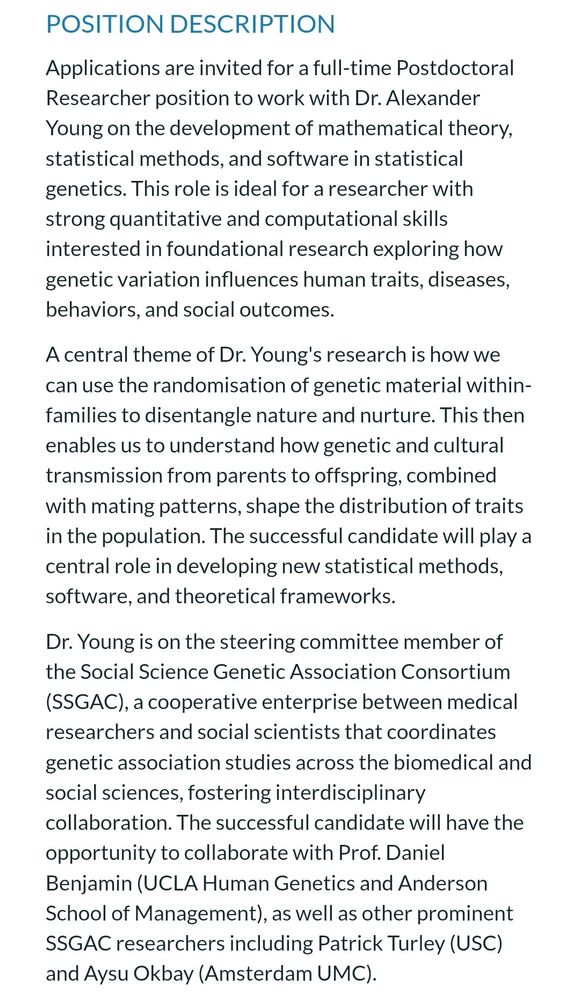
I am recruiting a quantitative/computational postdoc to my group at UCLA. This is a great opportunity to work on foundational theory, methods, and software in statistical genetics. Link to apply: recruit.apo.ucla.edu/JPF10275. Please repost!
28.04.2025 16:18 — 👍 12 🔁 17 💬 0 📌 1
: Application
Agreed! The opportunity for follow-up analyses is endless. One thing I forgot to mention here is that these weights are available in the Returns Catalogue to any researchers who use the UKB, under application# 55154: biobank.ndph.ox.ac.uk/ukb/app.cgi?...
16.04.2025 08:21 — 👍 1 🔁 0 💬 0 📌 0
Many thanks to my amazing co-authors: Ben Domingue, Jessica Faul, Titus Galama, and Andries Marees. This paper has been a 4-year long journey and I am so happy to finally see it out!
16.04.2025 08:04 — 👍 1 🔁 0 💬 0 📌 0
Overall, the message is clear: volunteer bias matters to GWAS results and downstream analyses. The extent to which it matters is phenotype-specific. The community should work on creating population-representative weights for various cohorts and incorporate these in GWAS.
16.04.2025 08:04 — 👍 0 🔁 0 💬 2 📌 0

WGWAS may also result in different bio annotations (as estimated in MAGMA). For example, the GWAS results for breast cancer show no enriched pathways. The WGWAS results are expressed in the fallopian tube, uterus, ovary, and Artery Tibial (Figure 3).
16.04.2025 08:04 — 👍 0 🔁 0 💬 1 📌 0
Furthermore, we find evidence that weighting GWAS results pushes the intercept of LD-score regression closer to 1, which indicates that weighting might also shield against bias due to population stratification.
16.04.2025 08:04 — 👍 0 🔁 0 💬 1 📌 0

WGWAS also resulted in larger SNP-based heritabilities for 7 out of the 10 phenotypes (Table 3). For example, Years of education shows a SNP-based heritability of 14.8% in GWAS, and 17.8% in WGWAS.
16.04.2025 08:04 — 👍 0 🔁 0 💬 1 📌 0
Note also that the effective sample size shrinks from 376,900 in GWAS to 143,222 in WGWAS averaged over all phenotypes, a shrinkage of 62%. Hence, representative samples would increase the power of GWAS, as power reduces when taking volunteer bias into account.
16.04.2025 08:04 — 👍 0 🔁 0 💬 2 📌 0

Next, we compare GWAS and WGWAS associations genomewide. The genetic correlation between GWAS and WGWAS results is lower than one for 6 out of 10 phenotypes. The lowest congruence between GWAS and WGWAS is found for Type 1 Diabetes (rG=0.66) and Breast Cancer (rG = 0.80). (Table 2)
16.04.2025 08:04 — 👍 0 🔁 0 💬 1 📌 0
The National Bureau of Economic Research is dedicated to conducting and disseminating nonpartisan economic research.
nber.org
PhD candidate @politicsoxford.bsky.social | Columnist @decorrespondent.nl | Rower @ox.ac.uk | views my own
The European Economic Association (EEA) is an International scientific body, with membership open to all persons involved or interested in economics, that promotes the development of economic science throughout Europe.
PhD student @UCL | behavioural genetics, psychopathology, cognition. AI ethics in a past life.
PhD Candidate | GxE Interplay of cognitive development and educational attainment at Max-Planck Research Group „Biosocial“
Macroeconomist, working on space, labour and inequalities | Postdoc @ INSEAD | Warwick PhD | https://www.gabrieleguaitoli.com
Clinical psych PhD candidate @ University of Virginia | Alzheimer's disease & cognitive aging | behavioral genetics & epigenetics
Labor economist, Assistant Professor at the University of Nebraska, PhD at the University of Chicago
Assistant Prof (TT) in Health and Labour Economics at University of Duisburg-Essen, dep. director CINCH, affiliated with IZA. dad³. Personal views.
passionately curious, econ phd student at @unibasel.bsky.social.
https://sites.google.com/view/andreaghisletta
Behavioral labor/health/public economist. Former RA @CFPB. @Swarthmore grad. Singer. Runner. Manhattan-born, Philadelphia-raised. Ph.D. @PittEcon 🇺🇸🇦🇹
PhD candidate in Economics at @UvA_Amsterdam || Education, Crime, Labor Economics
Personal Website: https://sites.google.com/site/maddalenatotarelli/home?authuser=0
https://www.geneticsnetworkamsterdam.org
Statistical Geneticist, Group leader at University of Lausanne/Unisante, father, climber, runner
Economics PhD candidate at Vrije Universiteit Amsterdam and the Tinbergen Institute. Working on applied econometrics, replication, and economics of science. https://jack-fitzgerald.github.io. Likes/reposts aren’t endorsements, views are my own.
CBS - NIDI - Sociologie - Demografie - Runner 🏃♂️
Alleen actief via: https://www.linkedin.com/in/rubenvangaalen/
PhD candidate and lecturer at Utrecht University School of Economics. Posting about research, economics, and politics. A reluctant cat person.
https://linktr.ee/svuukojevic
Postdoctoral Scholar @UCLA & Affiliate Fellow @broadinstitute of @MIT and @Harvard. Alumni @TuftsUniversity. GWAS of complex traits. Unraveling GxE effects.


